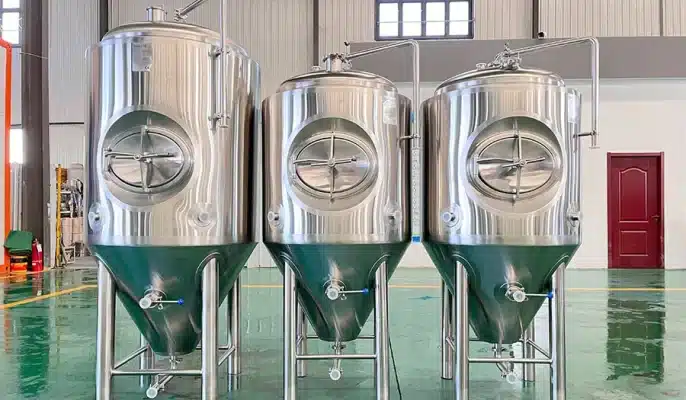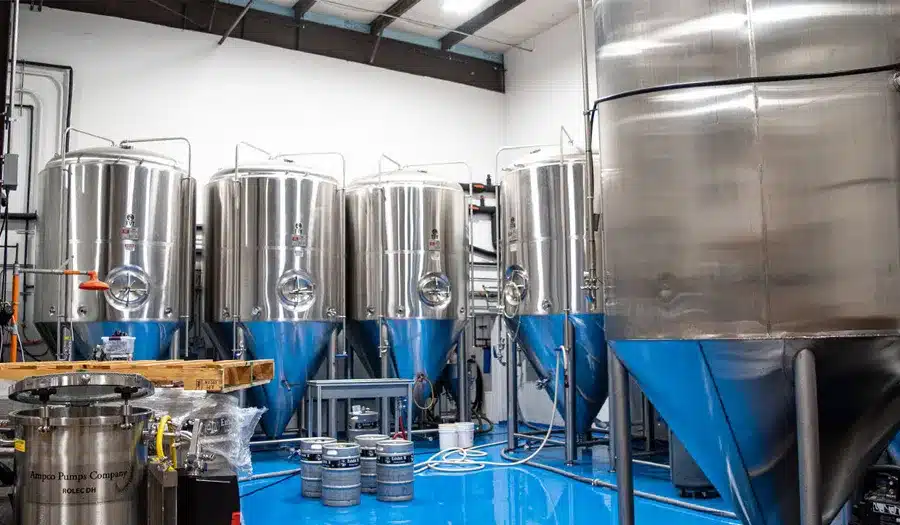The brewing process of beer is complex and sophisticated, and the most critical step is the fermentation stage. Fermentation is the process of converting maltose into alcohol and carbon dioxide, usually through the action of yeast. There are a variety of home-brewing beer fermenters on the market, with different sizes and different types of containers that are more suitable for different fermentation types. In the entire brewing process, the selection and use of fermentation containers are crucial because they directly affect the quality, taste, clarity, and storage life of the beer.
What is a beer fermentation container?
In the brewing process of beer, fermentation is a crucial stage. First, the brewer puts the saccharified malt liquid (wort) in contact with yeast, and the yeast reproduces at a suitable temperature and consumes the sugar in the wort, eventually producing alcohol and carbon dioxide. To ensure that this process can proceed smoothly, the brewer must choose a suitable fermentation container. The fermentation container must not only be able to hold the beer liquid but also provide a suitable environment for the yeast while preventing external contamination.
The choice of fermentation container is not only closely related to the flavor and quality of the beer but also affects the efficiency and stability of the brewing process. Generally speaking, fermentation vessels can be divided into primary fermentation vessels and secondary fermentation vessels according to their use stages and functions. Primary fermentation vessels are used in the initial stage of fermentation, while secondary fermentation vessels are used for subsequent processing and clarification of beer.

Fermentation vessel material
Plastic fermentation vessel
Plastic fermentation containers are mostly used for home brewing and low-cost small-scale production. Common plastic materials include high-density polyethylene (HDPE) and polypropylene (PP). These materials have strong corrosion resistance and good sealing properties.
Avantages
- Plastic containers are relatively cheap and are a common choice for home brewing.
- Plastic is relatively light and easy to carry and operate.
Inconvénients
- Some low-quality plastic materials may react with the chemical components in beer, affecting the taste of beer.
- The plastic surface is easily scratched, resulting in difficult-to-remove dirt, which in turn affects sanitary conditions.
Stainless steel fermentation vessel
Stainless steel fermentation vessel are commonly used in the commercial brewing field and are increasingly being adopted by home brewers. Stainless steel has excellent corrosion resistance and cleaning properties, so it is considered an ideal choice for high-quality brewing containers. Food-grade stainless steel (such as 304 and 316 stainless steel) is often used as the material of the fermentation tank to ensure that the beer is not contaminated during the brewing process. Even if it is exposed to alcohol, yeast, and other liquid ingredients for a long time, it will not be damaged.
Avantages
- Stainless steel vessel have a smooth surface, which makes them very easy to clean and disinfect, reducing the possibility of bacteria breeding.
- Stainless steel containers are very strong and durable, suitable for long-term use, and can be used repeatedly for many years.
- Stainless steel can withstand high temperatures, so it has good adaptability to temperature changes during the brewing process, especially for high-temperature fermentation processes.
- Stainless steel does not release any odors or harmful substances, which helps to maintain the original flavor and taste of beer.
Inconvénients
- Stainless steel vessel are relatively expensive and may exceed the budget of home brewing, especially large stainless steel fermentation tanks.
- Compared to plastic and glass, stainless steel containers are heavier and not as convenient to carry as other materials.
Glass fermentation vessel
Glass is a material commonly used for small fermentation containers for home brewing. It has good transparency, allowing brewers to see the fermentation process.
Avantages
- The transparency of glass containers allows brewers to observe the fermentation process and changes in beer at any time.
- Glass does not contain chemicals, which can ensure that the taste and flavor of beer are not affected.
- The surface of glass containers is smooth and easy to clean thoroughly, reducing the risk of bacterial contamination.
Inconvénients
- Glass containers are easy to break, so you need to be careful when carrying them. Improper use can easily cause damage.
- Although glass stainless steel containers are lighter, they are still heavier than plastic containers and may be more troublesome to carry and store.
- There may be some sediment inside the glass bottle, which is slightly more troublesome to clean than plastic and stainless steel containers, especially in the later stages of fermentation.

Wood fermentation vessel
Wood is not common in beer fermentation, but in some specific brewing techniques and special beer styles, wooden barrels still play an important role, especially in the brewing process of barrel-aging beer. The material of the wooden barrel can give the beer a unique flavor and aroma.
Avantages
- When the wooden barrel comes into contact with the beer during the fermentation process, it will release the aroma and chemical components of the wood, giving the beer a unique taste and flavor.
- In wooden barrel fermentation, the activity of microorganisms and the components of the wood interact, which often increases the complexity and layering of the beer.
- Wooden barrels occupy an important position in traditional brewing, and beer brewed in wooden barrels has a unique sense of history and tradition.
Inconvénients
- Wooden barrels require regular maintenance and cleaning, otherwise they may be contaminated by mold and bacteria.
- It is difficult to control the temperature and humidity of wooden barrel fermentation, and it is difficult for winemakers to accurately control the brewing conditions.
- Wooden barrels are expensive and require special care and maintenance after use, so the cost is high.
Types of vessels for fermenting beer
In the brewing process of beer, the fermentation stage is crucial, and the choice of fermentation vessel directly affects the quality, flavor, clarity, and storage effect of the beer. Different types of fermentation vessels are suitable for different brewing scales and technical requirements.
Fermentation barrels
Fermentation barrels are the most common fermentation vessels in home brewing and are also commonly used tools in small-scale brewing production. Fermentation barrels are usually made of plastic or stainless steel, with moderate capacity and easy operation, suitable for primary fermentation.
Avantages :
- Fermentation barrels usually have a large capacity, suitable for home or small-scale production, and can hold 10 to 30 liters of wort for fermentation.
- Fermentation barrels are usually equipped with sealing covers and air valves to effectively prevent external air from entering, ensure the closedness of the fermentation environment, and reduce the risk of oxidation and contamination.
- Many fermentation barrels are translucent or transparent, and brewers can easily observe the bubble activity and changes in beer during the fermentation process.
- Compared with stainless steel and glass vessels, plastic fermentation barrels are inexpensive and cost-effective, suitable for home brewing enthusiasts with limited budgets.
Inconvénients
- Plastic fermentation barrels are easily scratched and damaged and may crack after long-term use, affecting their service life.
- Low-quality plastic materials may release harmful chemicals, affecting the taste and flavor of beer.
- Plastic barrels are prone to accumulate brewing residues, which are troublesome to clean and disinfect and can easily become a breeding ground for bacteria.

Cuves de fermentation en acier inoxydable
Stainless steel fermentation tanks are one of the most commonly used fermentation vessels in commercial brewing and have gradually entered the home brewing market. Its material has strong corrosion resistance, durability, and easy cleaning, so it has been widely used in high-end brewing.
Avantages
- Strong corrosion resistance: Stainless steel has very good corrosion resistance, can withstand the reaction of chemicals in the brewing process, and is not easy to rust.
- Keep the original flavor of beer: Stainless steel materials will not release any substances that affect the flavor of beer, so they can maintain the original taste of beer.
- Easy to clean: The surface of stainless steel is smooth and very easy to clean. It can completely remove brewing residues and reduce bacterial growth.
- Good durability: Stainless steel fermentation tanks are very strong and durable, suitable for long-term use, and not easy to break.
- Strong airtightness: Most stainless steel fermentation tanks are equipped with air valves and sealing systems to effectively prevent the entry of external air and maintain the stability of the fermentation environment.
Inconvénients :
- The cost of stainless steel fermentation tanks is much higher than that of plastic vessels, so a higher budget is required for initial investment.
- Compared with plastic and glass vessels, stainless steel fermentation tanks are relatively heavy and not as convenient to carry as other vessel
- Some stainless steel fermentation tanks require additional equipment support, such as temperature control systems, air valves, etc., which are relatively complicated to operate.
Glass fermentation bottles
Glass fermentation bottles are often used in the secondary fermentation or storage stage of home brewing. Because glass is transparent and does not affect the flavor, it provides good visibility for brewers to observe changes in the fermentation process at any time.
Avantages :
- Good transparency: The transparency of glass vessels allows brewers to clearly observe the progress of fermentation and changes in beer liquid.
- Will not affect the flavor of beer: Glass is a neutral material that does not react with beer and does not change the taste of beer.
- Easy to clean: The glass surface is smooth and does not easily absorb residues. It is relatively easy to clean and is suitable for secondary fermentation.
Inconvénients :
- Fragile: Glass vessels are easy to break during transportation or operation and need to be used with caution.
- Difficult to clean: Although the surface of the glass is smooth, sediment and residue are easy to accumulate, so special attention needs to be paid when cleaning.
- Heavyweight: Compared with plastic, glass vessels are heavier and are not as convenient to carry as plastic and stainless steel vessel
Selection of fermentation vessel
Choosing a suitable fermentation vessel is not only determined by the material of the vessel but also by considering multiple factors. First, the fermentation vessel needs to have good sealing to prevent the entry of external oxygen, thereby avoiding oxidation and other bacterial contamination. Second, the vessel needs to be able to maintain the appropriate temperature, which is essential for the activity of yeast. Finally, the fermentation vessel also needs to have enough space to accommodate the carbon dioxide and foam produced during the fermentation process.
FAQ
Does the choice of fermentation vessel affect the flavor of beer?
Yes, the material and design of the fermentation vessel may affect the taste of beer. For example, wooden barrel fermentation can add a complex flavor to beer, while stainless steel and glass vessels can maintain the original flavor of beer.
Can the primary and secondary fermentation vessels be the same?
Yes, the primary and secondary fermentation vessels can be the same vessel, but usually in actual brewing, many brewers use two different vessels to separate the two stages, thereby improving the clarity and stability of the beer.
Will plastic fermentation barrels affect the taste of beer?
If the plastic used does not meet food safety standards or is of poor quality, it may affect the taste of the beer, so it is very important to choose a high-quality food-grade plastic fermentation barrel.
Is a glass fermentation bottle safe?
Glass fermentation bottles require care when used because they are more fragile. However, glass itself does not affect the taste of beer and is a relatively safe and commonly used vessel.




